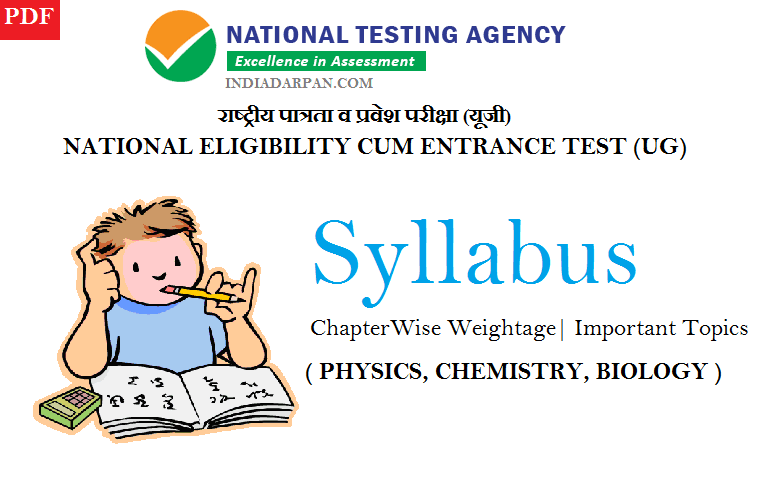- Education
- Updated on August 19, 2022
[PDF] NTA NEET 2022 Syllabus - Latest Chapter Wise Weightage

The National Eligibility cum Entrance Examination or the NEET is the most critical examination for the Medical education aspirants. If any Indian student wants to pursue education in the Medical field, then he/she has to pass the NEET 2022 examination.
National Test Agency conducts this examination, that’s why it is called as NTA NEET. The examination is held every year by the NTA. As it is the national level examination, the students have to prepare and study for it. But, how do they study? What is the latest NEET 2022 Syllabus?
Well, that’s what we are going to share in this article. For all those who are pursuing the dream of medical education and becoming the doctor should prepare themselves by studying from the prescribed syllabus. There should be a proper strategy for learning by checking out the syllabus for NEET examination.
Here, we are sharing the detailed syllabus for this exam, which is recommended by the National Testing Agency and will help you in scoring good marks.
Below, you’ll find the NTA NEET 2022 Syllabus PDF to download for free of cost. Just download all the books and start studying immediately.
Checkout these books
NTA NEET 2022 Syllabus – All Subjects
The NEET examination is for the admissions in all of the medical colleges in India. The students from Science stream are eligible to apply and appear in the final examination. As only students from Science stream are allowed, the subjects of this test are from the same stream. There are three main subjects for this entrance test. The first one is Physics, Second is Chemistry, and the third is Biology. The Biology is the topic of importance in this entrance test, and the other two are for the understandings of the students.
As everyone has studies these three subjects in the higher secondary level, there should be no difficulties for anyone to start studying the prescribed syllabus. Although the subjects are same, the chapters included in the latest NEET 2022 Syllabus might be different from what you’ve learned. Here is the detailed list of chapters in each subject.
Physics
| Class XI | Class XII |
|---|---|
| Physical World and Measurement | Electrostatics |
| Kinematics | Current Electricity |
| Laws of Motion | Magnetic Effects of Current and Magnetism |
| Work, Energy and Power | Electromagnetic Induction and Alternating Currents |
| Motion of System of Particles and Rigid Body | Electromagnetic Waves |
| Gravitation | Optics |
| Properties of Bulk Matter | Dual Nature of Matter and Radiation |
| Thermodynamics | Atoms and Nuclei |
| Behaviour of Perfect Gas and Kinetic Theory | Electronic Devices |
| Oscillations and Waves |
Chemistry
| Class XI | Class XII |
|---|---|
| Some Basic Concepts of Chemistry | Solid state |
| Structure of Atom | Solutions |
| Classification of Elements and Periodicity in Properties | Electrochemistry |
| Chemical Bonding and Molecular Structure | Chemical Kinetics |
| States of Matter: Gases and Liquids | Surface Chemistry |
| Thermodynamics | General Principles and Processes of Isolation of Elements |
| Equilibrium | p-Block elements |
| Redox Reactions | d and f Block Elements |
| Hydrogen | Coordination Compounds |
| s-Block Elements | Haloalkanes and Haloarenes |
| Some p-Block Elements | Alcohols, Phenols and Ethers |
| Organic Chemistry- Some Basic Principles and Techniques | Aldehydes, Ketones and Carboxylic Acids |
| Hydrocarbons | Organic Compounds Containing Nitrogen |
| Environmental Chemistry | Biomolecules |
| (-) | Polymers |
| (-) | Chemistry in Everyday Life |
Biology
| Class XI | Class XII |
|---|---|
| Diversity in Living World | Reproduction |
| Structural Organization in Animals and Plant | Genetics and Evolution |
| Cell Structure and Function | Biology and Human Welfare |
| Plant Physiology | Biotechnology and its Applications |
| Human Physiology | Ecology and Environment |
NEET 2021 Syllabus Chapter-wise Weightage
The examination is concentrated on the Biology subject, and the other subjects are for letting students understand the basic concepts useful further. The examination pattern is pretty simple, and each chapter has percentage weight. Not all chapters in all of the subjects are equal as some are simple and some are difficult. So, all you have to do to pass in this examination is to prepare the topics or chapters that have more weightage over the subjects that have low weightage of marks.
Here is the list of all of the chapters from all of the subjects and their respective percentage weightage. Just follow this weightage blueprint, and you’ll get a good idea of how you are going to study for the topics that are of utmost importance.
Physics Chapter wise Weightage for NEET 2021
Class XI | ||
Unit | Topic / Chapters | Weightage* |
I | Physical world and measurement | 2% |
Chapter–1: Physical World | ||
Chapter–2: Units and Measurements | ||
II | Kinematics | 3% |
Chapter–3: Motion in a Straight Line | ||
Chapter–4: Motion in a Plane | ||
III | Laws of Motion | 3% |
Chapter–5: Laws of Motion | ||
IV | Work, Energy and Power | 4% |
Chapter–6: Work, Energy and Power | ||
V | Motion of System of Particles and Rigid Body | 5% |
Chapter–7: System of Particles and Rotational Motion | ||
VI | Gravitation | 2% |
Chapter–8: Gravitation | ||
VII | Properties of Bulk Matter | 3% |
Chapter–9: Mechanical Properties of Solids | ||
Chapter–10: Mechanical Properties of Fluids | ||
Chapter–11: Thermal Properties of Matter | ||
VIII | Thermodynamics | 9% |
Chapter–12: Thermodynamics | ||
IX | Behaviour of Perfect Gas and Kinetic Theory | 3% |
Chapter–13: Kinetic Theory | ||
X | Oscillation & Waves | 3% |
Chapter–14: Oscillations | ||
Chapter–15: Waves | ||
Class XII | ||
Unit | Topic / Chapters | Weightage* |
I | Electrostatics | 9% |
Chapter-1: Electric Charges and Fields | ||
Chapter-2: Electrostatic Potential and Capacitance | ||
II | Current Electricity | 8% |
Chapter-3: Current Electricity | ||
III | Magnetic Effect of Current & Magnetism | 5% |
Chapter-4: Moving Charges and Magnetism | ||
Chapter-5: Magnetism and Matter | ||
IV | Electromagnetic Induction & Alternating Current | 8% |
Chapter-6: Electromagnetic Induction | ||
Chapter-7: Alternating Current | ||
V | Electromagnetic Waves | 5% |
Chapter-8: Electromagnetic Waves | ||
VI | Optics | 10% |
Chapter-9: Ray Optics and Optical Instruments | ||
Chapter-10: Wave Optics | ||
VII | Dual Nature of Matter and Radiation | 6% |
Chapter-11: Dual Nature of Radiation and Matter | ||
VIII | Atoms & Nuclei | 3% |
Chapter-12: Atoms | ||
Chapter-13: Nuclei | ||
IX | Electronic Devices | 9% |
Chapter-14: Semiconductor Electronics | ||
Total | 100% | |
Chemistry Chapter wise Weightage for NTA NEET 2021
Class XI | ||
Unit | Topic / Chapters | Weightage* |
I | Basic Concepts of Chemistry | 1% |
II | Structure of Atom | 2% |
III | Classification of Elements & Periodicity in Properties | 2% |
IV | Chemical Bonding and Molecular Structure | 5% |
V | States of Matter: Gases and Liquids | 2% |
VI | Thermodynamics | 8% |
VII | Equilibrium | 6% |
VIII | Redox Reactions | 3% |
IX | Hydrogen | 3% |
X | s-Block Elements | 2% |
XI | Some p-Block Elements | 2% |
XII | Organic Chemistry: Basic Principles & Techniques | 4% |
XIII | Hydrocarbons | 3% |
XIV | Environmental Chemistry | 2% |
Class XII | ||
Unit | Topic / Chapters | Weightage* |
I | Solid State | 2% |
II | Solutions | 5% |
III | Electrochemistry | 2% |
IV | Chemical Kinetics | 3% |
V | Surface Chemistry | 2% |
VI | Isolation of Elements | 2% |
VII | p-Block Elements | 5% |
VIII | d- and f-Block Elements | 4% |
IX | Coordination Compounds | 9% |
X | Haloalkanes and Haloarenes | 3% |
XI | Alcohols, Phenols and Ethers | 4% |
XII | Aldehydes, Ketones and Carboxylic Acids | 4% |
XIII | Organic Compounds containing Nitrogen | 2% |
XIV | Biomolecules | 3% |
XV | Polymers | 3% |
XVI | Chemistry in Everyday Life | 2% |
Total | 100% | |
Biology Topic wise Weightage for NEET 2021
Class XI | ||
Unit | Topic / Chapters | Weightage* |
I | Diversity of Living Organisms | 14% |
Chapter-1: The Living World | ||
Chapter-2: Biological Classification | ||
Chapter-3: Plant Kingdom | ||
Chapter-4: Animal Kingdom | ||
II | Structural Organisation in Plants & Animals | 5% |
Chapter-5: Morphology of Flowering Plants | ||
Chapter-6: Anatomy of Flowering Plants | ||
Chapter-7: Structural Organisation in Animals | ||
III | Cell: Structure and Function | 9% |
Chapter-8: Cell-The Unit of Life | ||
Chapter-9: Biomolecules | ||
Chapter-10: Cell Cycle and Cell Division | ||
IV | Plant Physiology | 6% |
Chapter-11: Transport in Plants | ||
Chapter-12: Mineral Nutrition | ||
Chapter-13: Photosynthesis in Higher Plants | ||
Chapter-14: Respiration in Plants | ||
Chapter-15: Plant – Growth and Development | ||
V | Human Physiology | 20% |
Chapter-16: Digestion and Absorption | ||
Chapter-17: Breating and Exchange of Gases | ||
Chapter-18: Body Fluids and Circulation | ||
Chapter-19: Excretory Products and Their Elimination | ||
Chapter-20: Locomotion and Movement | ||
Chapter-21: Neural Control and Coordination | ||
Chapter-22: Chemical Coordination and Integration | ||
Class XII | ||
Unit | Topic / Chapters | Weightage |
VI | Reproduction | 9% |
Chapter-1: Reproduction in Organisms | ||
Chapter-2: Sexual Reproduction in Flowering Plants | ||
Chapter-3: Human Reproduction | ||
Chapter-4: Reproductive Health | ||
VII | Genetics and Evolution | 18% |
Chapter-5: Principles of Inheritance and Variation | ||
Chapter-6: Molecular Basis of Inheritance | ||
Chapter-7: Evolution | ||
VIII | Biology and Human Welfare | 9% |
Chapter-8: Human Health and Diseases | ||
Chapter-9: Strategies for Enhancement in Food Production | ||
Chapter-10: Microbes in Human Welfare | ||
IX | Biotechnology and its Applications | 4% |
Chapter-11: Biotechnology – Principles and Processes | ||
Chapter-12: Biotechnology and its Application | ||
X | Ecology and Environment | 6% |
Chapter-13: Organisms and Populations | ||
Chapter-14: Ecosystem | ||
Chapter-15: Biodiversity and its Conservation | ||
Chapter-16: Environmental Issues | ||
Total | 100% | |
Final Words
The examination for the admissions in almost every medical institution in India is prestigious. Every student, who has a dream of becoming the doctor or equivalent has to pass the NEET examination. We’ve discussed the same in another article. The key to success in this examination is the study. The students have to study hard and understand the concepts to get good marks in this test. And that is only possible if you have the right NEET books with the proper syllabus.
I hope you’ll find the PDF books of the syllabus prescribed by Testing Agency, on which the entire test is based on. Download them on your computer or smartphone and start studying immediately to get success and admission in the medical college of your choice.
Join the discussion
Related Articles
No results available
ResetTrending Articles


- General
- Updated on December 27, 2025


- General
- Updated on December 22, 2025


- General
- Updated on December 20, 2025


- General
- Updated on December 16, 2025


- General
- Updated on December 15, 2025


- General
- Updated on December 11, 2025


- General
- Updated on December 11, 2025


- General
- Updated on December 11, 2025


- General
- Updated on December 2, 2025


- General
- Updated on December 5, 2025
No results available
Reset



